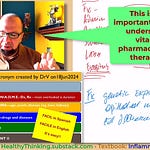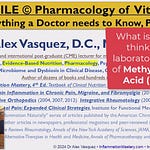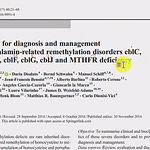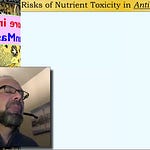To get the most out this exercise, you should look at the questions first—they are provided below
All videos from the course HUMAN MICROBIOME AND DYSBIOSIS IN CLINICAL DISEASE are being re-uploaded in Feb-Mar 2025 to provide direct and reliable access through the substack platform:
Can you answer these 10 questions on dysbiosis and microbiome?
VIDEO with discussion of QUESTIONS and ANSWERS 1-5 with Test-Taking Strategies
QUESTIONS and ANSWERS for Dysbiosis & Microbiome (6-10) with Test-Taking Strategies
Microbiome Dysbiosis (1) Course Overview and Introduction to Major Concepts and Mechanisms
Microbiome Dysbiosis (2) Physiologic and Pathologic Mechanisms of Dysbiosis and Subclinical Microbial Colonizations (VIDEO:1hour,15minutes)
Microbiome Dysbiosis (3) Prototypes of Dysbiosis-Induced Disease (VIDEO:1hour,42minutes=102minutes)
Microbiome Dysbiosis (4) Conceptual Expansion Exploring Clinical Testing, Microbial Relevance and Irrelevance [VIDEO:1hour,18minutes=78minutes]
Microbiome Dysbiosis (5) Microbial Consequences in the Mouth, Oral Cavity [VIDEO:1hour,44minutes=104minutes]
Microbiome Dysbiosis (6) Microbial Imbalances in the Respiratory Tract and Sinuses [VIDEO:1hour,35minutes=95minutes]
Microbiome Dysbiosis (7) Dysbiosis by Location—Genitourinary Tract
Microbiome Dysbiosis (8) Dysbiosis by Location—Blood, Tissue, Parenchymal Dysbioses
Microbiome Dysbiosis (9) Dysbiosis by Location—Skin and Environmental Dysbiosis
and several other videos for many hours more—these will be posted progressively over the next few days into March2025
VIDEO above with discussion of QUESTIONS and ANSWERS 1-5 with Test-Taking Strategies
To get the most out this exercise, you should look at the questions first:
1. A young child is brought to your office for treatment of eczema. Atopic dermatitis is commonly known as eczema and is generally treated with antiinflammatory agents (e.g., "steroid cream"), antihistamines, immunosuppressants, immunomodulators, and moisturizers. Patients with atopic dermatitis show increased production of IgE and histamine following exposure to which of the following microbes, and eradication of this microbe via the use of antimicrobials (eg, cephalexin, diluted hypochlorite baths) results in clinical alleviation:
A. Candida albicans
B. Saccharomyces boulardii
C. Streptococcus pyogenes
D. Pseudomonas aeruginosa
E. Staphylococcus aureus
F. Klebsiella pneumoniae
G. Escherichia coli
2. Your patient developed an autoimmune disorder following an infection. Amino acid homology produces molecular mimicry, which is necessary for the resultant immune cross-reactivity. Cross-reactivity between sequences in Acinetobacter and Pseudomonas aeruginosa is most relevant for patients with:
A. Chronic fatigue syndrome / systemic exertion intolerance
B. Fibromyalgia
C. Ankylosing spondylitis
D. Neuritis
E. Atopic dermatitis
F. Psoriasis
G. Antiphospholipid antibody syndrome
3. Your patient presents with persistent nasal congestion and crusting and had a recent event of hemoptosis. ANCA-associated vasculitis (formerly Wegener’s granulomatosis, also called "granulomatosis with polyangiitis") is a life-threatening autoimmune/vasculitic disease which is most commonly associated with colonization/dysbiosis of which of the following microbes, which produces an antigenic acid phosphatase enzyme which haptenizes to vascular endothelial cells to create an immunogenic neoantigen:
A. Candida albicans
B. Saccharomyces boulardii
C. Streptococcus pyogenes
D. Pseudomonas aeruginosa
E. Staphylococcus aureus
F. Klebsiella pneumoniae
G. Escherichia coli
4. A radiologist asks you about the mechanism of action and clinical benefits of probiotics. Probiotic foods and prebiotic nutritional supplements have gained wide popular and professional use and acceptance over the past several years. Which of the following are expected to be increased by administration of probiotic bacteria:
A. Superantigens and LPS and IL-10
B. BactDNA and H2S and p-cresol
C. Butyrate and p-cresol and tyramine
D. Superantigens and p-cresol
E. Butyrate and IL-10 and Treg
F. Th17 and IL6
5. Your patient has suffered from a debilitating illness for many years. Which of the following conditions is most noteworthy for being characterized by SIBO, mitochondrial impairment, neuroinflammation (“brain inflammation”) and deficiency/insufficiency of L-tryptophan and co-enzyme Q10 (ubiquinone):
A. Chronic fatigue syndrome / systemic exertion intolerance
B. Fibromyalgia
C. Ankylosing spondylitis
D. Neuritis
E. Atopic dermatitis
F. Psoriasis
G. Antiphospholipid antibody syndrome
Sample PDF downloads:
Click here to see the first few pages, including the table of contents and index (size: 6 MB)
Click here for a larger sample with photos (size: 43 MB)
CONFERENCE VIDEO Integrating Functional and Naturopathic Medicine (F.I.N.D.S.E.X.® Protocol) into Medical Practice for Common Primary Care and Specialty Conditions [2020, Moscow]
·This presentation was scheduled to be delivered physically in Moscow in 2020, but obviously the globalists had other plans for us and international travel was canceled during the European lockdown.
Microbiome Dysbiosis (2) Physiologic and Pathologic Mechanisms of Dysbiosis and Subclinical Microbial Colonizations (VIDEO:1hour,15minutes)
·UPDATE Feb-Mar 2025: I’ve noticed that some of the videos previously posted/streaming from the Vimeo platform are no longer reliably visible, while at the same time, this Substack platform has progressively allowed for direct uploading/embedding of videos; as such, many of the previously-posted videos are being reloaded directly into the Substack platform for more reliable access and archiving.



![CONFERENCE VIDEO Integrating Functional and Naturopathic Medicine (F.I.N.D.S.E.X.® Protocol) into Medical Practice for Common Primary Care and Specialty Conditions [2020, Moscow]](https://substackcdn.com/image/fetch/$s_!Kbmu!,w_1300,h_650,c_fill,f_auto,q_auto:good,fl_progressive:steep,g_auto/https%3A%2F%2Fsubstack-video.s3.amazonaws.com%2Fvideo_upload%2Fpost%2F152107091%2Fa8110bd8-2b8c-4b8d-9bbb-fef2cf697b89%2Ftranscoded-00001.png)









